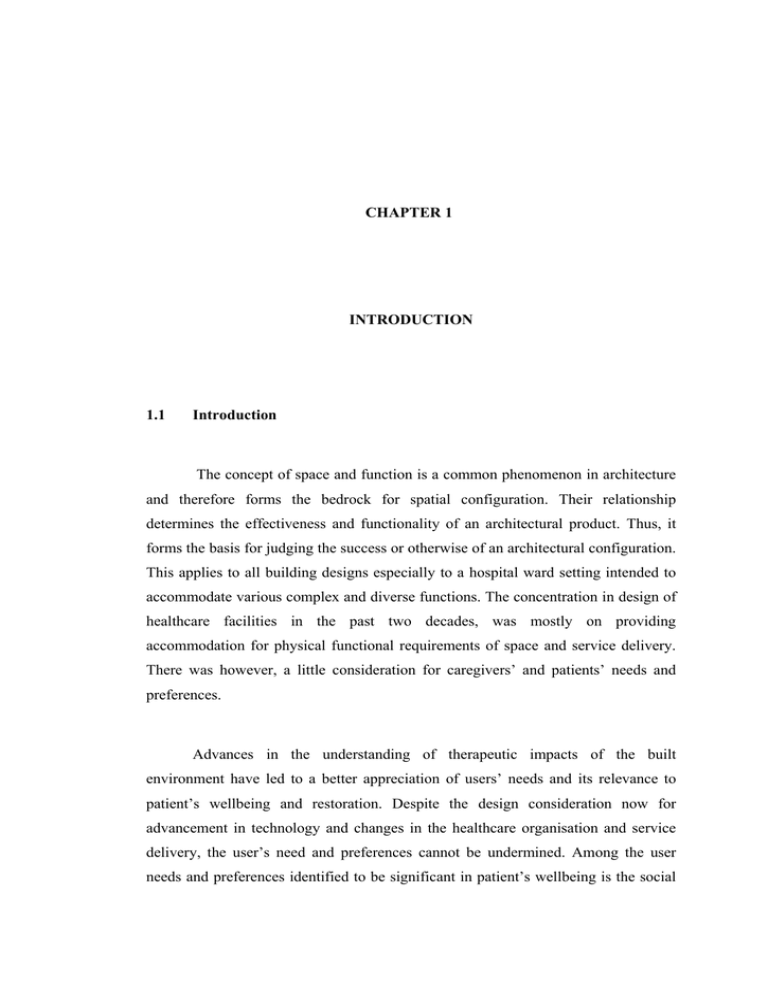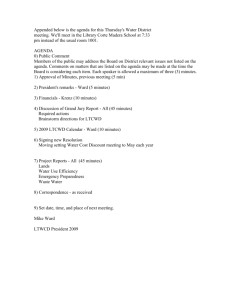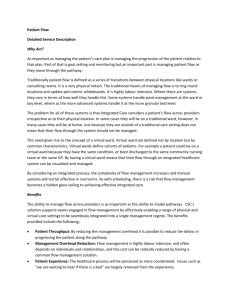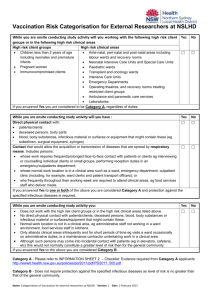1 The concept of space and function is a common phenomenon... and therefore forms the bedrock ... CHAPTER 1
advertisement

1 CHAPTER 1 INTRODUCTION 1.1 Introduction The concept of space and function is a common phenomenon in architecture and therefore forms the bedrock for spatial configuration. Their relationship determines the effectiveness and functionality of an architectural product. Thus, it forms the basis for judging the success or otherwise of an architectural configuration. This applies to all building designs especially to a hospital ward setting intended to accommodate various complex and diverse functions. The concentration in design of healthcare facilities in the past two decades, was mostly on providing accommodation for physical functional requirements of space and service delivery. There was however, a little consideration for caregivers’ and patients’ needs and preferences. Advances in the understanding of therapeutic impacts of the built environment have led to a better appreciation of users’ needs and its relevance to patient’s wellbeing and restoration. Despite the design consideration now for advancement in technology and changes in the healthcare organisation and service delivery, the user’s need and preferences cannot be undermined. Among the user needs and preferences identified to be significant in patient’s wellbeing is the social 2 support from family. Hence the need for identifying and integrating their related functions in the hospital ward design. According to Dursun (2007), design process in architecture is not an automatic or procedural process but rather a process of making discovery that is preceded by formulating and testing ideas. This however, involves taking design constraints into consideration and the use of evidence based knowledge. In line with the above, this thesis looks at familial caregiving concept in Nigerian hospitals and explores the possibility of considering the familial caregiving as component of hospital spatial provision. This is achieved through studying the family actions and interactions in the course of caring for their hospitalised relatives, and examining the space activity relationship in order to evolve a framework that provides for their accommodation and ultimately informed design decision. This chapter therefore comprise of eleven sections spanning through problem statement, research gap, research aim, main research question, research objectives, research questions, research methodology, significance of the study, research scope and ended with description of the thesis structure. 1.2 Problem Statement Negotiating spaces to accommodate patient families in Nigerian hospital wards has continued to make the spaces non-conducive to the patients, their families and even the staff. An appraisal of several previous studies particularly those associated with familial caregiving have exposed the extent of family participation in caring for hospitalised relatives in a hospital setting, particularly in developing countries like Nigeria where patients on admission are expected to be accompanied with one or more family members whom they stay with throughout the hospitalisation period. 3 Even though, family presence and participation have been evidently proven to support restoration, however, the extent of their involvement varies. While purpose of patient family’s involvement in advanced countries is to provide emotional support, collaboration in care and decision making, however, those in developing countries like Nigeria, the engagement of family goes beyond the biomedical functions. The patient families take full responsibility of feeding, washing patients, escorting them to toilet, assisting them in their activities of daily living (Lasebikan and Oyetunde, 2012). This has been mostly attributed to inadequate staffing, customs and traditions (Brown, 2012; Hoffman et al., 2012; Uneke et al., 2007). For instance, the services provided by the formal caregiving to hospitalized patient in Kenya and Tanzania was found not to be sufficient, thereby necessitating the family care givers of the patient to provide supplementary support (Brown, 2012; Hoffman et al., 2012). Furthermore, Brown (2011) observed that the nurse’s responsibility in the wards did not include washing patients, helping patients to use the toilet, feeding patients who could not eat by themselves, however, such care was provided by family members. Similarly, the caregiving scenarios is not different in Tanzania (Zarins, 2010), in Malawi (Hoffman et al., 2012), and in Turkey (Evren and Okten, 2011). Despite the fact that hospital ward setting in Nigeria has no provision that will accommodate the families and their activities, however, the effect of family presence has changed the landscape of the hospital ward setting. Thus, spaces were rendered inadequate, activities and functions negotiating spaces they were not configured to accommodate, consequently, resulting into an uncoordinated sprawl that are not healthy to the hospital ward setting. Even though societies may have their own preferred way of caring that is in line with their culture and beliefs, however, the sacredness of a hospital ward has to be maintained (Irinoye, et al, 2006; Onyebochukwu, 2009). Therefore an evidence based approach is required in designing hospital ward setting that provide for the family presence and participation in Nigerian hospitals. This research seeks to investigate the actions and interaction of patient family in the hospital ward setting. 4 1.3 Research Gap How hospital spaces are designed and configured has significant implications on patients’ family, since care provided to a patient is by extension to the family. Thus family needs in a hospital are crucial issues that cannot be undermined (O’Connor et al., 2012). This corroborates the principles of family centred care which acknowledges that a patient is rooted in and part of a greater social structure and web of relationships (Khosravan, 2014). The presence of patients’ families during hospitalization have been established to offer immeasurable benefits in restoration (Lucchese et al, 2008). Thus, it becomes pertinent to identify and understand their needs during hospitalization so as to plan a befitting intervention. While several studies attempted to identify the need of members of the families especially of patients in intensive care units (Heyland and Tranmer, 2001; Khalaila, 2013; Mitchel and Chaboyer, 2010), little is known of the needs of families of hospitalised adult patients in wards at general hospitals (Lucchese et al., 2008). While majority of the studies carried out in this regard are from nursing perspective (Al-Mutair et al., 2013; Davidson, 2009; Hashim and Hussin, 2012; Khalaila, 2013), only few studies were carried out from the discipline of architecture (Diana, 2012). For instance studies in acute environments where the overwhelming focus is on resuscitation and management of the acutely ill patient, only psychological family needs are acknowledged and attended to (Diana, 2012; Hignett and Lu, 2010) There was little or no attention given to space for family presence in a hospital setting, for instance, in ambulatory care, a unit associated with emergency and resuscitative, is known for its overcrowding in the waiting rooms and treatment areas, with minimal or no physical space for family members to be present (Lucchese et al., 2008). Similarly, in the Intensive Care Unit (ICU) environment, where patient 5 families are under immense psychological and psychosocial pressure, yet, they lack space for private family communication or discussions and decision making (O’Connor et al., 2012). However, the concentration of improvement of hospital spaces in general wards, senior care, and mental health is generally on the patient’s needs because how patients' attitudes, goals, needs and expectations are met determines the level of satisfaction of hospitalisation (Clark, 2014). Hence, the integration of patient’s need in healthcare planning process reflect a growing concern within healthcare over the issue of patient satisfaction and option for choice as envisaged by the evidence based design concept (Gupta et al., 2007; Harris et al., 2006; Kant and Gupta, 2002; Lawson, 2005; Mourshed and Zhao, 2012; Stichler, 2012; Zhao et al, 2009). While the significance of family participation in restoration is becoming widely accepted, studies on familial caregiving was predominant in the field of nursing (McCabe, 2014; Abdelhadi and Drach-Zahavy, 2012; Cioffi, 2006; Fine, 2010; Kuo et al., 2012; Mitchel and Chaboyer, 2010; Reinhard et al, 2008), healthcare management (Lawlor and Cheryl, 1997; MacKean et al., 2005; Surenti, 2009), engineering (Mourshed and Zhao, 2012; Yau et al., 2010; Zhao and Mourshed, 2012), and in the areas of psychology and anthropology (Brown, 2012). The concentration of such studies was mostly related to specialised cases, such as paediatric, dementia, psychiatric and geriatric and intensive care. Ultimately, the literatures continue to show how family presence serve as an effective tool in improving patient’s outcome, communication, satisfaction and ultimately cost reduction (Evren and Okten, 2011a; Heyland and Tranmer, 2001; Khosravan et al., 2014; Kuo et al., 2012; Siminoff, 2013). This has necessitated the healthcare organizations to embrace the concept of family involvement and participation. Consequently, in spite of the wide recognition of the eminence of family presence in a hospital setting and participation on the physical, mental, emotional and spiritual wellbeing of patients, it appear as if there is no comprehensive design measure or framework that will evaluate the spatial needs of the patient family 6 especially in hospital wards. Similarly, there is scarce information that will guide the design process, especially in developing countries like Nigeria. The studies by architects on healthcare environment tend to focus more on privacy, impact of facilities on wellbeing, safety, sustainability, ventilation, flexibility, and innovations among others (Alalouch, 2009; Evren and Okten, 2011; Hamilton, 2008; Harris, et al, 2006; Kant and Gupta, 2002; Lindahi, 2012; Skoog, 2006; Street and Coleman, 2012; Ulrich et al., 2004; Vavili, 2004). However, the ultimate solution arrived at in providing for the family accommodation was the paradigm shift to single room accommodation and now to acuity adaptable rooms that has designated zones for families overnight stay (Reid et al,; 2014; Scottish Executive, 2013; Jasmine, 2004; Harris, et al, 2006; Laura, 2006; HermanMiller, 2010). But hospitals are seen as the most expensive aspect of the health care delivery system being the most expensive to build and operate (Baurman, 2013). Perhaps, this paradigm shift seems not to be feasible in most of the developing countries due to either weak economies, competing demands or poor healthcare delivery systems such as Nigeria, Turkey, Kenya, Tanzania, South Africa among others, who accommodate majority of their patients in an open ward type (Åstedt-Kurki et al., 1999; Fleba, 2005; Ogunniyi et al., 2005; Nawawi, 2007; Surenti, 2009; Evren and Okten, 2011; Brown, 2012). This is because such ward type are less expensive, easy to manage and maintain and above all require less workforce than the single room hospital type (Brown, 2012; IUSS, 2013). Therefore it become pertinent to have a framework that will guide the provision for family presence and participation in hospitals accommodating their patients in an open ward type. This will ensure that the needs and preferences of patients that has to do with social support are met. Furthermore, it will give an enabling environment for embracement of the principles of patient and family centred care. 1.4 Research Aim 7 To propose a design framework that provides for familial care practices in Nigerian hospital ward with a view to informing design decision. 1.5 Research Main Question How can Nigerian hospital wards be configured to provide for familial caregiving? 1.6 Research Objectives The following objectives have been set out to achieve the aim. 1. To explore the significance of familial caregiving concept in Nigerian hospital wards; 2. To examine the implication of familial caregiving on hospital ward spaces; and 3. To determine the design indicators of ward configuration with familial caregiving. 1.7 The Research Sub Questions Three research questions that will cover the research context of developing the design framework were generated and asked as follows; 1. Why is familial caregiving a necessity in Nigerian hospital wards? 2. How do the hospital ward spaces accommodate family care actions? 8 3. What are the design indicators required in guiding hospital ward configuration with provision for familial caregiving? 1.8 Research Methodology In responding to the problem statement outlined and the research objectives, a process by which these objectives could be achieved efficiently is needed. Two basic patterns of study emerged from the context of the study: familial caregiving concept and spatial usage patterns. Understanding the dimensions of the family caregiving and its spatial implication required in achieving the goal of this study situated it in a qualitative research dimension. Therefore these factors form the basis for sampling and data collection strategies that are guided by different research philosophies that are informed by epistemological understandings. At first instance, the basis for choosing the study setting and sample for this research was based on how best to elicit the required data. Subsequently, a purposeful sampling with information based criteria was used in the selection of hospital for the study. Secondly, in conducting evaluative inquiry into space-activity relationship, a pragmatic approach based on the principles of phenomenology is employed. Phenomenological strategy mostly employed in healthcare environment research provides an avenue to generate a description of a phenomenon of everyday experience so as to achieve an understanding of its essential structure (MalagonMaldonado, 2014). This is obviously attributed to the ability of mining deep insight of the lived experience of the patient family in the course of caring for their hospitalised relatives in their natural setting. The phenomenology here apply the use of interviews, drawings, field observation, photography and behavioural mapping in eliciting required information. In order to have a broader understanding of the 9 dimension of familial caregiving in Nigerian hospital wards, a quantitative approach was used to triangulate with a qualitative approach used. A close ended questionnaire with Likert scaling was used in obtaining the result required. The survey is directed towards revealing the extents of the factors responsible for the familial caregiving. Finally, a design charrette was organised with stakeholders in healthcare and design was conducted to arrive at a comparative stand on the familial caregiving in hospital. The data obtained was analysed using content analysis and structural equation modelling. The qualitative data obtained was analysed using different forms of content analysis for data reduction, description, and interpretation of the patient family’s actions and interactions in the hospital ward setting. Similarly, advanced statistical analysis package IBM SPSS Statistics 20 was used in organising the data for further psychometric analysis. Subsequently Structural Equation Modelling (SEM-AMOS) was used for structural analysis and further Confirmatory Path Analysis (CFA). It therefore implies that this study is employing a combined multi strategy approach by using both qualitative and quantitative strategies of data collection and analysis. The details of these applications are presented under the methodology section in Chapter 4. Findings from the dimension of familial caregiving and space activity relationship are presented in tables, figures, models and descriptive narration. 1.9 Research Significance By illuminating the emerging roles of patient families during hospitalisation that made their involvement a crucial aspect of hospital ward regimen, this study contributes to the body of knowledge by revealing the ideal model of care that redefined the functional requirements of a hospital ward design in Nigeria. 10 The study as well demonstrates that even though the family involvement in caring for their hospitalised relatives has complimented the poor hospital ward operations, however, the caring roles was found to be more of family process and functions as enshrined in cultural etiquettes of a typical Nigerian family. Remarkably, the study has come up with design attributes required in configuring family conscious hospital ward setting that can be applied in majority of hospitals of African societies sharing common healthcare setting and family structure, functions and processes. 1.10 Scope and Limitations Considering the fact that hospitals are of different types, sizes and categories with different wards types accommodating various forms of illness and age categories, this study was is limited to male and female adult surgical ward setting of a tertiary public hospital, owned and operated by the federal government of Nigeria. By limiting the study in this type of hospital setting, the findings of this study may not be generalizable to other ward types. Similarly, there may also be limit to which the findings can be applicable in hospitals of different hierarchy. 1.10.1 The Study Context The study seeks to explore the dimension of familial caregiving in hospital wards. However, hospital facility is broad and has various types and strata. The classification can be based on the capacity, ownership or specialisation (Alalouch, 2009). The capacity uses number of beds in determining whether small, medium or large hospitals, the classification based on stratification groups hospitals into 11 primary, secondary and tertiary hospitals; whereas ownership group them into public or private. However, specialisation categorise them into speciality (Cox and Groves, 1990). This study is therefore focused on the tertiary public hospital based on the above classifications. A public tertiary hospital in Nigeria is a hospital owned and operated by the federal government. The setting and principles of operation is the same around the whole country. Furthermore, being a referral hospital, it draws it patients across all cultures thereby giving opportunity for study across cultures. 1.10.2 The Research Setting This study was conducted in male and female adult surgical inpatient setting of Federal Medical Centre Gombe (now Federal University Teaching Hospital). The methodology section of Chapter 4 elaborates further on the strategies used in choosing the hospital and the ward type. However the classification of hospital types into public and private and their categorisation into primary, secondary and tertiary hospitals informed the choice and limitations to public tertiary hospital. In addition the classification of hospital wards based on ailment and age also informed the limitation of the choice of ward to adult surgical wards. 1.10.3 Units of Analysis Considering the fact that there are many departments in a hospital with doctors and nurses spread across based on specialities. This study is limited to healthcare personnel directly attached to the inpatient department. The details of the personnel category is also elaborated in methodology section in Chapter 4. 1.11 Structure of Thesis 12 The thesis progression is described in four sections comprising of six interconnected chapters that are organised in a logical and systematic way in addressing the research objectives. The details is shown in Figure 1.1 and subsequently described in details. Figure 1.1: Summary of thesis structure Section 1: Introduction This consists of preamble as well as opening pages which consist of abstract, acknowledgement, table of contents, dedication and certification, list of tables and figures, list of appendices and the glossary. Chapter One: introduces the study by highlighting the research background. In addition, the problem the research intends to address is also stated so as to portray 13 the picture for comprehension of the research, thereby revealing the research gap. Furthermore, the research goal is defined by clearly stating the aim of the study. Subsequently the study objectives which later translates into research questions were also clearly spelt out. Before describing the outline of the research methodology, the research significance is clearly itemised, and subsequently, the scope and limitations of the study is defined. Section 2: Review of Literature The review of literature consists of two chapters, the second chapter focuses on the hospital architectural process and healthcare system, while the third chapter concentrates on the relationship of the family and healthcare system. Chapter Two: Literature on hospital architectural process and healthcare system was reviewed to acquaint the study with the healthcare facilities design intricacies and the healthcare systems. The chapter covers literature on the association of healthcare facilities and the services rendered. In addition, it also describes the architectural processes of hospital design ranging from design considerations to planning. It further reviews the transformational trends in healthcare architecture. Furthermore, the study covers the review on Nigerian health care setting, from its evolution to the emergence of organised health care system. The chapter concludes with study on the drivers for the paradigm shift in healthcare architecture. Chapter Three: This chapter present the review of related literature on the concept of family and the symbiotic relationship with health which forms the basis for the foundation for the development of the theoretical and conceptual frameworks. The chapter give account of the family behaviour in health and illness in addition to the health and family relationship described. In conclusion, the chapter describes further the concept of a family setting from its structure, functions and processes in global and local Nigerian context. 14 Section Three: Methodology This section consists of two chapters that covers the methodological framework of the study, statement of account of fieldwork conducted and discussion of results. The fourth chapter discusses the research planning, procedure and its analytical process as well while the fifth chapter presents and discusses the results and findings. Chapter Four: This chapter describes in details, the philosophical paradigm, theory, methods, strategies and tactics employed during the study. It gives detail accounts of how the research is conducted in response to the research problem and questions. How data is collected and analysed is also described in detail. Furthermore, it describes the outline of the strategies adopted in establishing the trustworthiness of the research process that is in line with the scientifically accepted procedures. Chapter Five: The chapter presents results, and report finding from the analysis carried out in chapter four and subsequently discusses the result that finally generates an analytical outcome. Section Four: Conclusion Chapter six: This chapter covers the conclusion made based on the findings. The chapter clearly demonstrates the research claim, presents the architectural design implication and makes recommendation for further research. Reference: this presents the outline of cited works in the dissertation. Appendices: consist of supporting documents that enhanced the conduct of the study.




